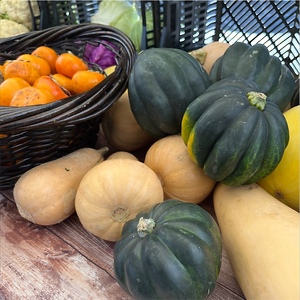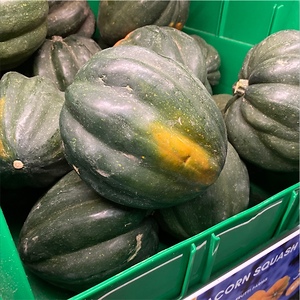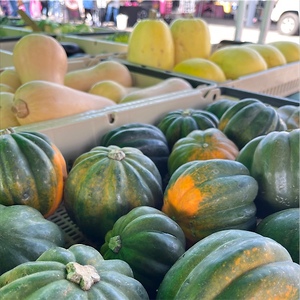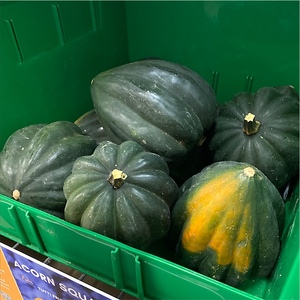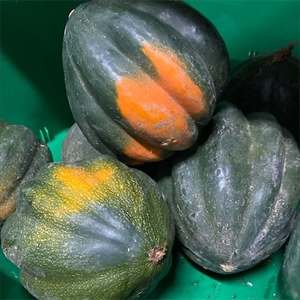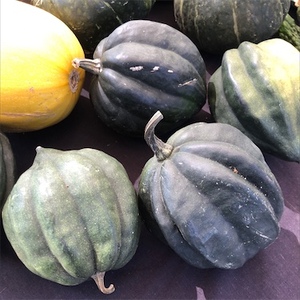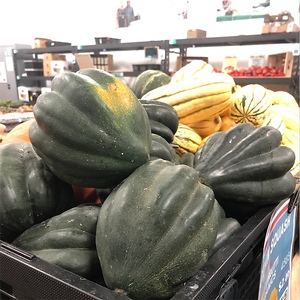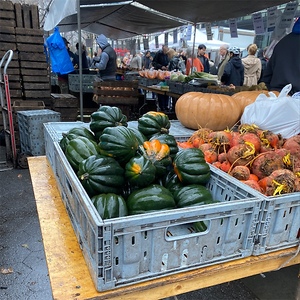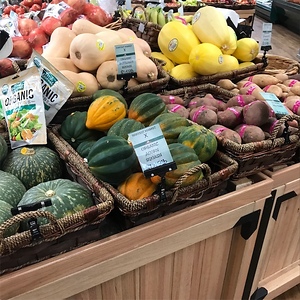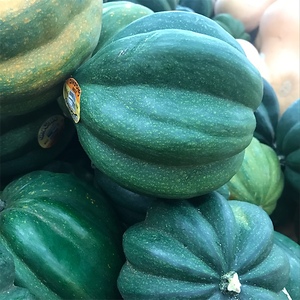

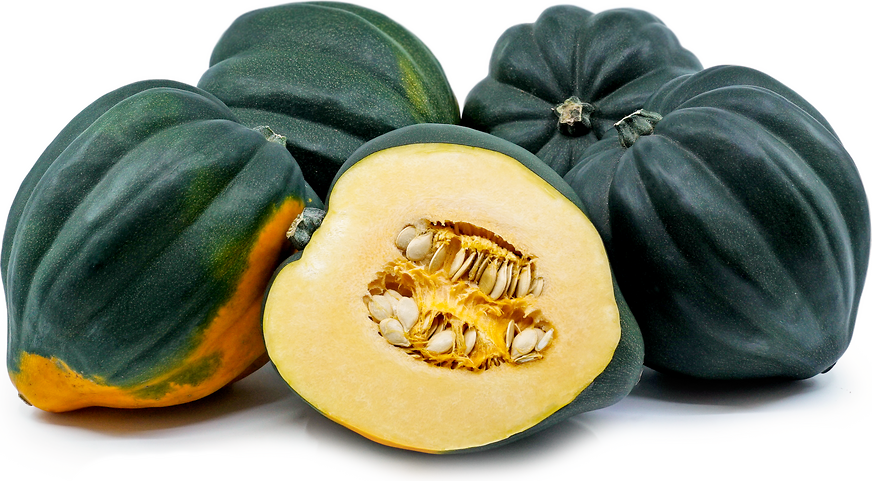
Green Acorn Squash
Estimated Inventory, 35 lbs : 4.00
This item was last sold on : 07/09/25
Description/Taste
Green Acorn squash is a medium-sized vegetable that measures about 13 to 20 centimeters long and 10 to 13 centimeters wide. It weighs between 0.5 and 1 kilogram which is relatively dense for its size. This variety has an ovoid shape lined with deeply furrowed ridges that taper to a point on the opposite of the stem end. Green Acorn squash has a light green rind when young that deepens to dark green with yellow and orange patches as it matures. This thin rind is smooth, hard, and slightly glossy and may display small lighter-colored speckles across its surface. It's attached to a short dark green stem that feels rough to the touch. Green Acorn squash has a golden yellow flesh that’s spongy and moist yet drier than other varieties like Butternut squash. This firm layer of flesh has a hollow center that contains stringy pulp encasing many small, flat, cream-colored seeds. Green Acorn squash becomes tender when cooked and takes on a mildly sweet, nutty, and buttery flavor.
Seasons/Availability
Green Acorn squash is available year-round with a peak season from fall to winter.
Current Facts
Green Acorn squash is botanically classified as Cucurbita pepo and belongs to the Cucurbitaceae family which also includes cucumbers, gourds, melons, and pumpkins. This variety is commonly referred to as Pepper squash, Des Moines squash, and Danish squash. Green Acorn squash is labeled as a winter squash which means that it has hard skin, sturdy flesh, and is harvested in the fall. It's technically classified as a fruit but is often referred to and cooked as a vegetable. Acorn squash is a category of squashes that have a ridged acorn shape. Green is the most common color but they may also have an orange, yellow, white, striped, or spotted rind. There are many different varieties including Autumn, Celebration, Cream of the Crop, Heart of Gold, Royal Ace, and Table Queen Acorn squash. Green Acorn squash can be used decoratively alongside pumpkins for fall displays or in a variety of cold-weather recipes.
Nutritional Value
Acorn squash is a significant source of vitamins C, B6, and A. These are essential for immune function, iron absorption, hormone regulation, and oxygen transportation as well as for collagen, energy, and red blood cell production. These vitamins also help with eye, reproductive, and cellular health. Acorn squash contains potassium and manganese to promote muscle and nerve function, wound healing, bone formation, fluid balance, metabolism, and blood pressure regulation. This vegetable provides the body with thiamine and magnesium. These assist with digestion, nutrient absorption, cognitive function, blood sugar control, mood and stress regulation, and heart health.
Applications
Green Acorn squash is best suited for cooked applications such as roasting, baking, stuffing, broiling, sautéing, steaming, and grilling. Its rind is edible so it’s often left on when cooked. This squash can be halved, baked, and used as a bowl stuffed with meats, cheese, grains, and roasted vegetables. It’s frequently incorporated into roasted Acorn squash soup that's puréed with yellow onions, fresh thyme, Kabocha squash, and topped with sour cream or créme fraîche. Green Acorn squash can be incorporated into curries, risotto, pasta, and stuffings. It can also be used in sweet dishes like breads, cakes, and pies. Green Acorn squash pairs well with robust cheeses, mushrooms, celery, pecans, cranberries, apples, raisins, sausage, ground beef, bacon, blackened chicken, butter, olive, oil, and balsamic vinegar. This vegetable is complemented by herbs and spices like sage, thyme, rosemary, parsley, cilantro, ginger, and cinnamon. Homegrown Green Acorn squash can be stored for 2 to 3 months. Store-bought Green Acorn squash can be kept in a cool and dark place for up to a month. It will last for about two weeks in the refrigerator once it's cooked and sliced.
Ethnic/Cultural Info
Green Acorn squash was an important crop for many Native American tribes. It was among the numerous squash varieties that were part of a group of crops known as the three sisters: corn, beans, and squash. Native American cultures relied on them as their main food sources and grew them together as these crops have a mutually beneficial relationship and can boost nutrients in the soil to increase yields. Acorn and other winter squash varieties were valued because they could be stored for long periods of time during the winter when food was more scarce. The leaves, blossoms, and young shoots of the vegetable were all consumed on a regular basis. One of the ways they would use Acorn squash was baked over fire coals and served with maple syrup, walnuts, pecans, raspberries, and blueberries. They would also dry the squash to use it as a small container. European explorers would later adopt these methods of growing and preparing Acorn squash after visiting the New World.
Geography/History
Green Acorn squash is native to North America and is thought to have originated from the Arikara tribe in North Dakota. This vegetable grows in warm-temperate and tropical climates. A variation of Green Acorn squash may have once been found in the wild but this variety has now been cultivated for centuries to achieve its unique size and mild flavor. It's primarily grown commercially and in home gardens. Green Acorn squash was mostly cultivated by Native Americans until Robert Fullerton brought their seeds to Des Moines, Iowa, in the late 1800s. He shared them with the seed-growing Sestier brothers and around 1913 the Iowa Seed Company began commercializing the variety. Acorn squash is now one of the most popular squashes in North America where it can be commonly found at grocery stores and farmers' markets. It’s also frequently sold in Central and South America, Asia, and Europe and sown in gardens throughout the world.
Featured Restaurants
Restaurants currently purchasing this product as an ingredient for their menu.
| The Farm Golf Club | Rancho Santa Fe CA | 858-756-5585 |
| Pacific Regent La Jolla | San Diego CA | 858-597-8008 |
| Harley Gray Kitchen and Bar | San Diego CA | 619-840-7000 |
| Solterra Winery + Kitchen | Encinitas CA | 858-245-6146 |
| Reata Glen | Ladera Ranch CA | 949-545-2250 |
| Cape Rey Carlsbad, a Hilton Resort | Carlsbad CA | 760-602-0800 |
Recipe Ideas
Recipes that include Green Acorn Squash. One



